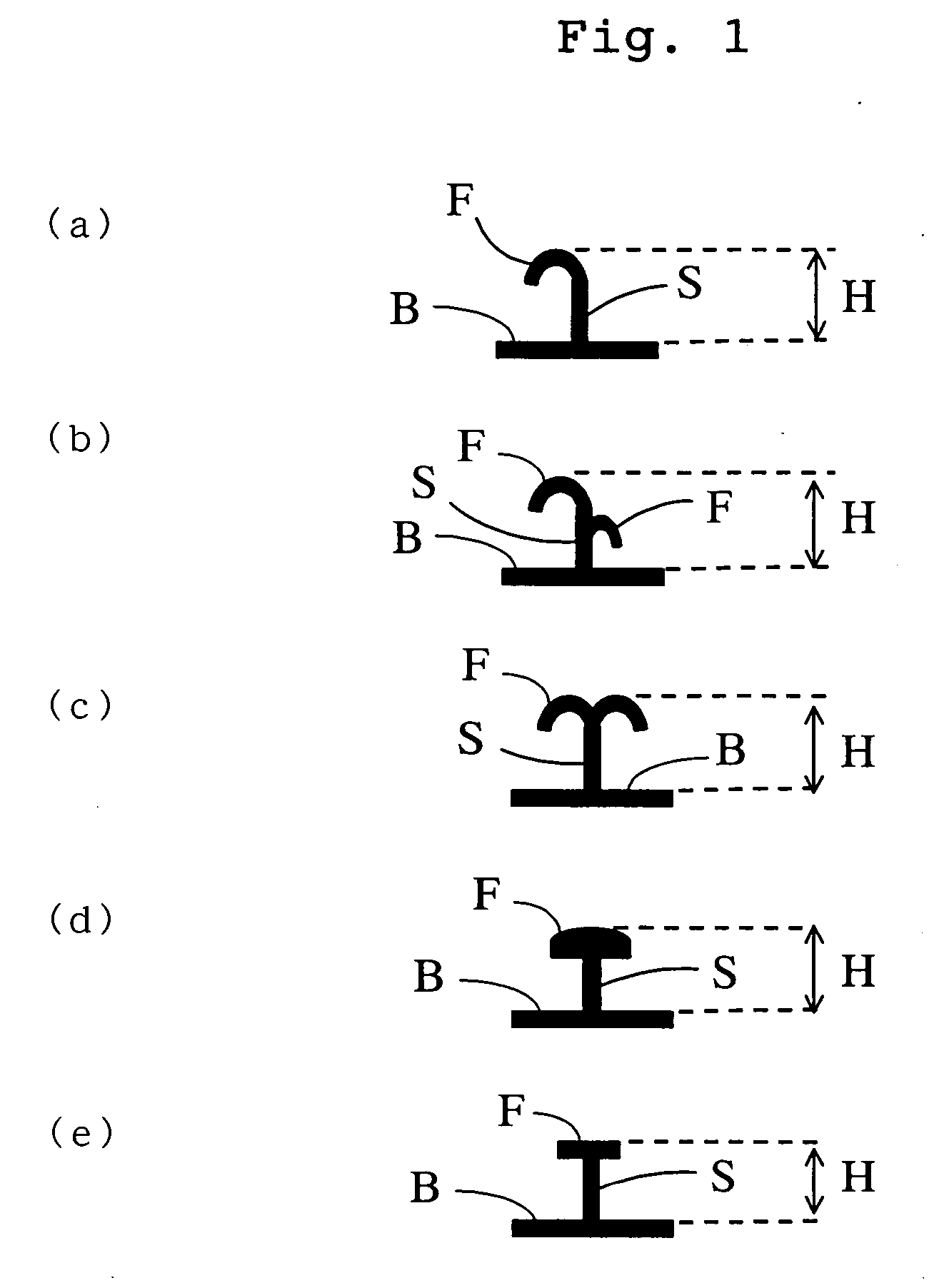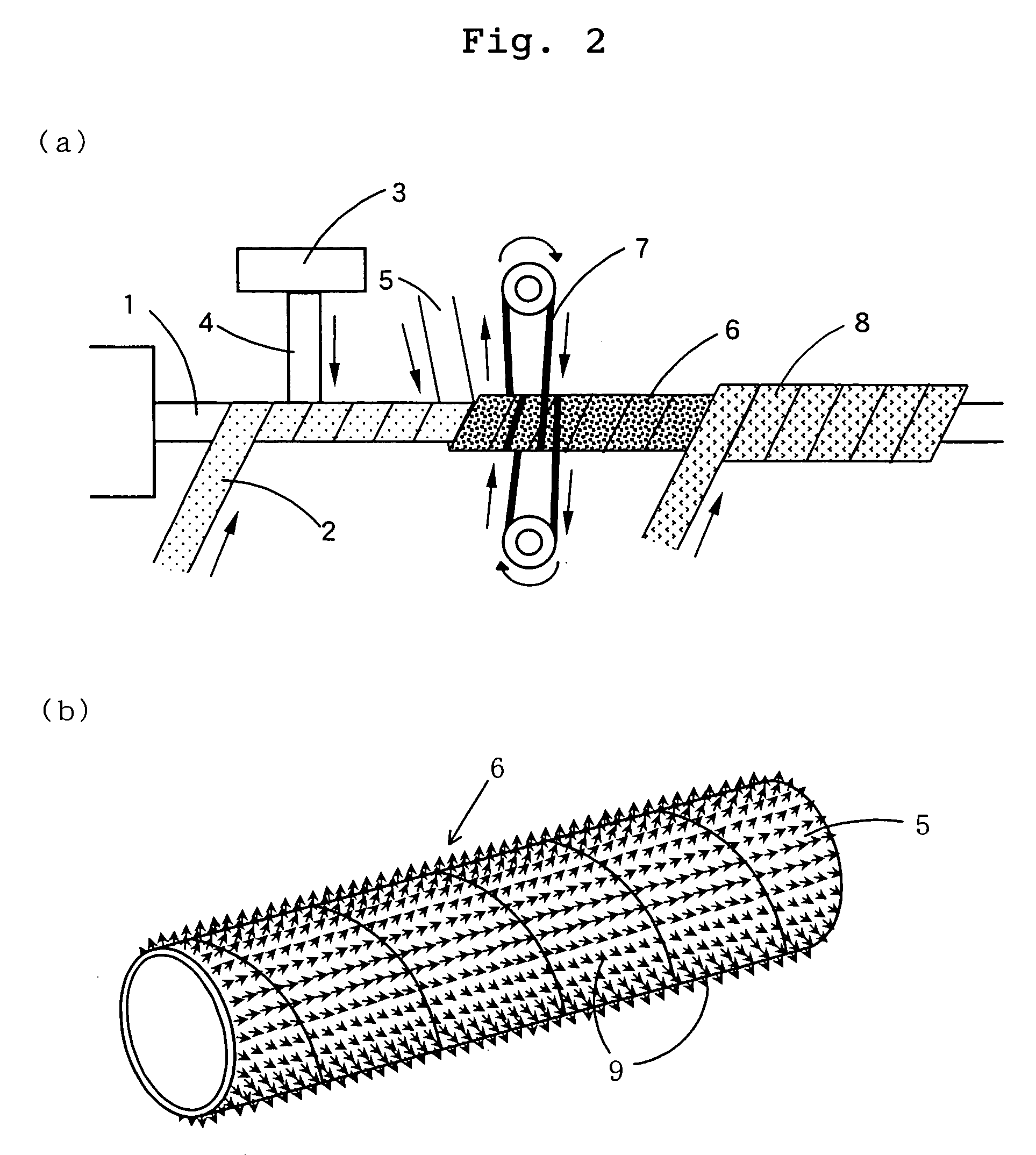Paint roller
- Summary
- Abstract
- Description
- Claims
- Application Information
AI Technical Summary
Benefits of technology
Problems solved by technology
Method used
Image
Examples
example 1
[0100] (1) Production of a Loop Thread:
[0101] One nylon filament thread (140 dtex / 14 filaments; manufactured by Toray industries, Inc.) as a sheath thread and one heat-fusing fiber (a sheath-core type conjugated fiber in which the core component comprised a polyethylene terephthalate and the sheath component comprised an ethylene-vinyl alcohol-series copolymer; 165 dtex / 48 filaments) as a core thread was fed to Taslan (a registered trademark of Heberlein Fiber Technology Inc.) nozzle (“#15” manufactured by Heberlein) at a feed rate of the core thread of 1.10 and a feeding rate of the sheath thread of 1.50, and subjected to Taslan process under an air pressure of 540 kPa (5.5 kg / cm2) and a processing speed of 200 m / min. to produce a process thread (loop thread) having 410 dtex / 62 filaments (the average loop number per cm of the thread: 22).
[0102] (2) Production of a Cover Member
[0103] Two polyester filament threads (276 dtex / 48 filaments) were provided for pile threads. One loop t...
example 2
[0110] (1) The same cover member as those obtained in EXAMPLE 1 (2) was adequately cut into a scrollwork pattern and a geometrical pattern to give a plurality of cover member pieces.
[0111] (2) A tubular core member with the male element on a surface thereof was produced by the same step as in EXAMPLE 1 (i), and this preparatory core member was directly cut into length of 23 cm (without attaching the cover member) to produce a tubular core member having the given length (23 cm).
[0112] (3) The plurality of cover member pieces produced in the above (1) were attached to the surface of the tubular core member in length of 23 cm produced in the above (2) at a space from each other, to give a effect roller.
[0113] (4) The painting with the effect roller produced in above (3) achieved that the same pattern design as the pattern on the surface of the effect roller was smoothly painted on a surface to be painted.
example 3
[0114] (1) Production of the Cover Member
[0115] (i) Two polyester filament threads (276 dtex / 48 filaments) were provided for pile threads. Two polyester false-twisted filament thread (220 dtex / 72 filaments) and one heat-fusing fiber filament (filament thread; 165 dtex / 48 filaments; “Sophista” manufactured by Kuraray Co., Ltd.) were used as ground yarns. The above ground yarns were aligned and knitted with a circular knitting machine to give a woven fabric having a pile made of the polyester filament thread on the upper surface (weight of the woven fabric: 540 g / m2, thickness of the woven fabric: 7 mm, pile density on the upper surface: 22 / cm2, and average pile height: 7 mm).
[0116] (ii) With the use of a polyester false-twisted thread (80 dtex / 24 filaments), a tricot fabric (weight of the woven fabric: 150 g / m2, thickness of the woven fabric: 1.5 mm) was produced, then one surface of the tricot fabric was raised with a raising machine to produce a tricot raising fabric.
[0117] (iii...
PUM
| Property | Measurement | Unit |
|---|---|---|
| Length | aaaaa | aaaaa |
| Height | aaaaa | aaaaa |
| Density | aaaaa | aaaaa |
Abstract
Description
Claims
Application Information
 Login to View More
Login to View More - R&D
- Intellectual Property
- Life Sciences
- Materials
- Tech Scout
- Unparalleled Data Quality
- Higher Quality Content
- 60% Fewer Hallucinations
Browse by: Latest US Patents, China's latest patents, Technical Efficacy Thesaurus, Application Domain, Technology Topic, Popular Technical Reports.
© 2025 PatSnap. All rights reserved.Legal|Privacy policy|Modern Slavery Act Transparency Statement|Sitemap|About US| Contact US: help@patsnap.com



